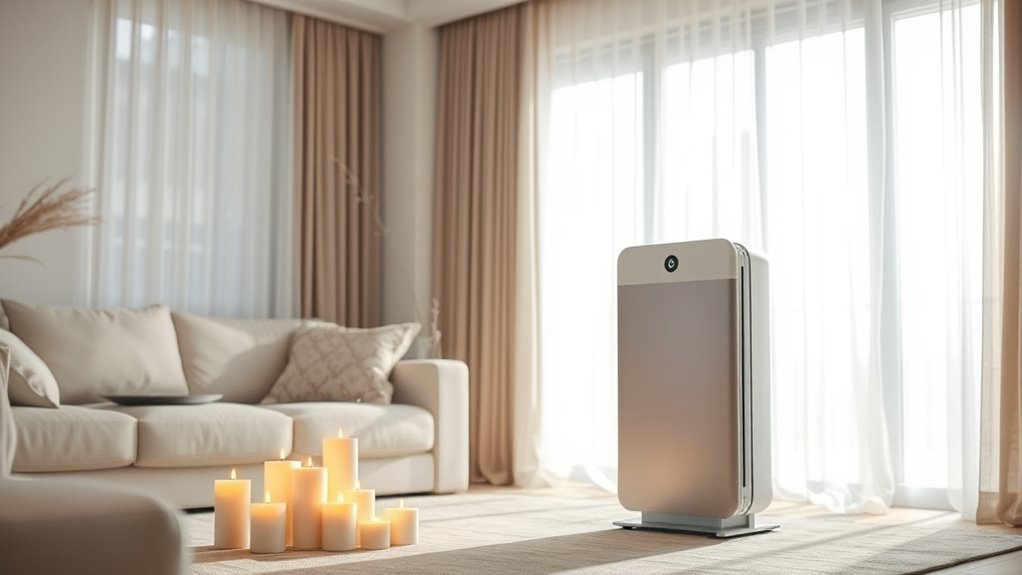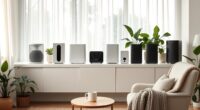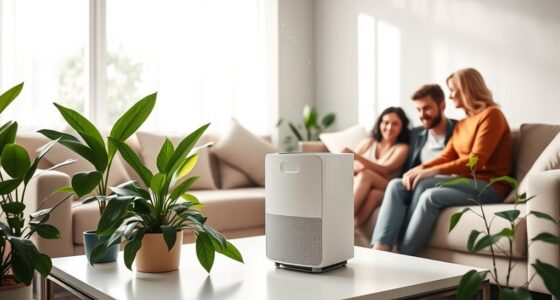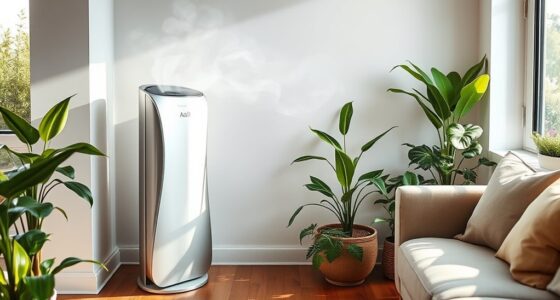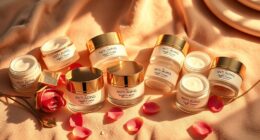Balancing the enjoyment of scented candles with good indoor air quality is essential for your health. Scented candles release VOCs that can harm sensitive individuals, causing respiratory issues and other health effects. Instead, consider safer alternatives like beeswax or soy candles and use air purifiers to combat indoor pollutants. These purifiers effectively filter out toxins and improve air quality. By making informed choices, you can enjoy fragrance while keeping your space healthy—learn more about finding that balance.
Key Takeaways
- Scented candles can release VOCs and particulate matter, negatively impacting indoor air quality and health, especially for sensitive individuals.
- Air purifiers equipped with HEPA and activated carbon filters effectively remove VOCs, allergens, and pollutants, enhancing overall air quality.
- Using beeswax or non-GMO soy candles can be safer alternatives, reducing harmful emissions compared to traditional scented candles.
- Balancing fragrance with air quality involves minimizing scented candle use while maintaining a clean environment with regular air purifier maintenance.
- Consider using air purifiers alongside natural air purifying plants to create a healthier indoor atmosphere without compromising on fragrance.
Understanding Indoor Air Quality Concerns
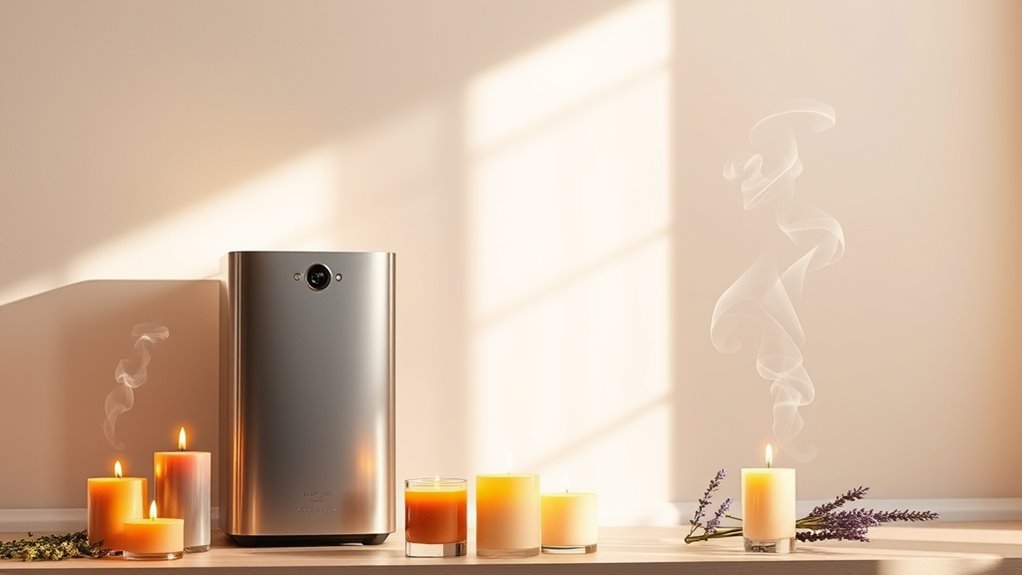
Indoor air quality is a critical yet often overlooked aspect of our health. Since you spend 85-90% of your time indoors, the air you breathe can greatly impact your well-being.
Indoor pollution levels can be over three times higher than outdoor levels, exposing you to harmful substances. Common sources include cooking, heating, and burning scented candles, which release volatile organic compounds (VOCs) into the air. Air purifiers can effectively capture these VOCs and improve your indoor environment. Regular cleaning processes for air purifiers can enhance their ability to filter out these harmful substances. Additionally, many air purifiers utilize HEPA filters to capture airborne particles effectively.
To maintain their efficiency, it’s essential to regularly check and clean filters, ensuring optimal performance. These VOCs can lead to respiratory issues, eye irritation, and headaches. Frequent exposure to indoor air pollutants can exacerbate conditions like asthma and increase the risk of serious diseases. To safeguard your health, consider improving indoor air quality through proper ventilation, regular cleaning, and using air purifiers to filter out harmful pollutants. Additionally, using air purifiers equipped with HEPA filtration can significantly reduce allergens and improve overall air quality.
The Role of Volatile Organic Compounds (VOCs)
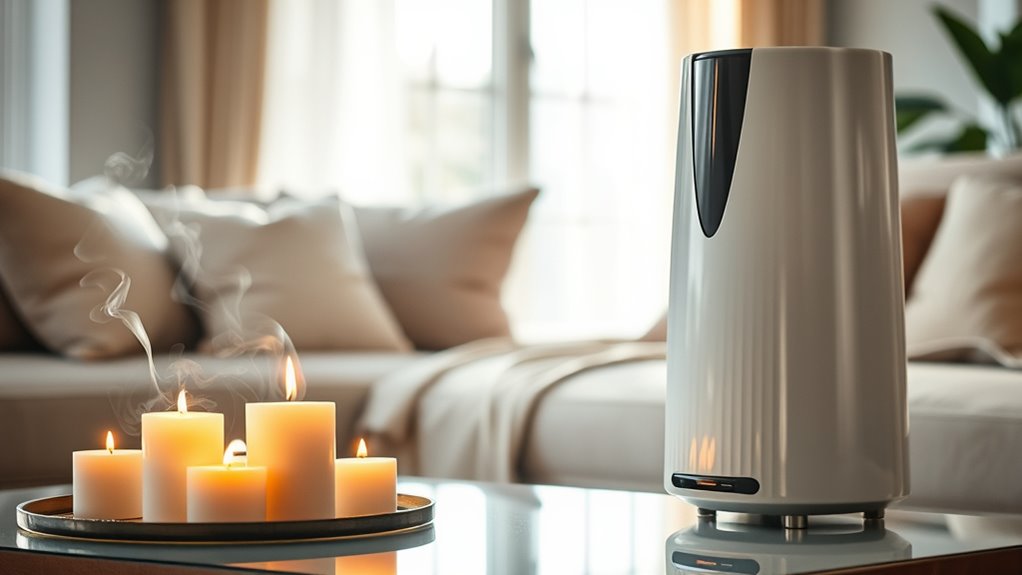
When you light a scented candle or spray an air freshener, you mightn’t realize you’re releasing volatile organic compounds (VOCs) into your home. These compounds can greatly impact your indoor air quality and health, with concentrations often exceeding outdoor levels. Understanding the sources and potential health implications of VOCs is essential for creating a safer living environment. Incorporating an air purifier equipped with HEPA filters can significantly reduce the presence of VOCs and other airborne pollutants, enhancing overall air quality. Additionally, using essential oils as natural alternatives can help improve indoor air quality without introducing harmful chemicals. It is important to note that certain oils, like tea tree and eucalyptus, can be toxic to pets, so always ensure pet safety when using essential oils in your home. Regular maintenance of your air purifier is crucial for optimal performance and effective pollutant reduction. Moreover, using energy-efficient systems like heat pumps can further improve indoor air quality by reducing reliance on fossil fuels and enhancing overall home sustainability.
Sources of VOCs
Volatile Organic Compounds (VOCs) are sneaky culprits lurking in many common household products, particularly air fresheners and scented candles.
These products can release harmful VOCs like formaldehyde and toluene, contributing to indoor air pollutants that can affect your health. Additionally, certain divorce processes may lead to increased use of home products, further exposing individuals to VOCs during stressful times. The prevalence of AI in marketing strategies can help brands create safer, low-VOC alternatives to traditional products. To enhance your home’s environment, consider incorporating natural elements like plants that can help purify the air. Moreover, emotional neglect in relationships can lead individuals to seek comfort in products that may harm their health.
You might be surprised to learn that indoor levels of VOCs can exceed outdoor levels by three times, heightening the risk of health issues.
Here are some common sources of VOCs:
- Air fresheners
- Scented candles
- Paints and varnishes
- Cleaning products
- Building materials
Being aware of these sources will help you make informed choices about your home environment.
Additionally, frequent use of cleaning products containing VOCs can significantly worsen indoor air quality.
Reducing your exposure to VOCs can lead to better indoor air quality and improved overall health.
Health Implications of VOCs
Many people don’t realize that exposure to VOCs can have serious health implications, especially when these compounds are present in common household items like air fresheners and scented candles. Burning candles can release harmful VOCs, contributing to indoor air pollution. This pollution can lead to respiratory issues, headaches, and increased cancer risks for sensitive individuals. Individuals with emotional dysregulation may be particularly vulnerable to the effects of indoor air pollution. To promote healthier indoor environments, it’s important to limit exposure to harsh environmental factors that can exacerbate these issues. Using air purifiers with HEPA filters can significantly reduce the concentration of VOCs in indoor air, much like how low-fat or non-dairy options can help manage dietary concerns related to health. Additionally, using essential oils for respiratory health can provide a natural alternative for improving air quality while minimizing VOC exposure.
| Health Issue | VOC Source | Effect |
|---|---|---|
| Respiratory Issues | Scented Candles | Difficulty breathing |
| Headaches | Air Fresheners | Chronic pain |
| Increased Cancer Risk | Various VOCs | Long-term exposure effects |
With no safe threshold for their presence indoors, it’s essential to be aware of VOCs and consider their impact on your health.
Misleading “Green” Labels and Their Impact
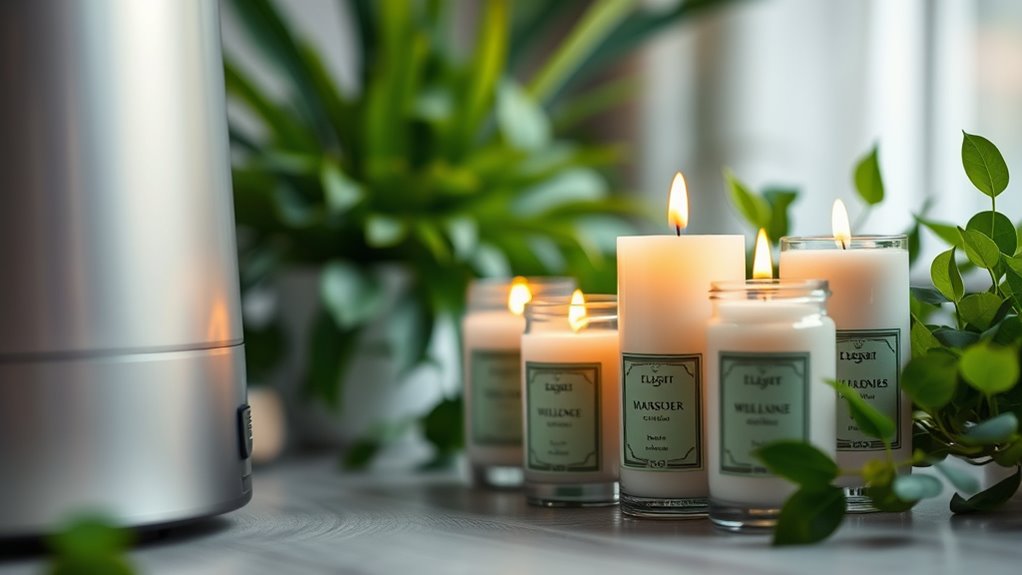
Misleading “green” labels can create a false sense of security for consumers seeking healthier home environments.
While you might think you’re making eco-friendly choices, many products labeled as “natural” or “organic” can still emit hazardous materials. This can lead to increased indoor air pollution, often from volatile organic compounds (VOCs) that these products release.
- Air fresheners can emit over 100 chemicals.
- Essential oils can create harmful byproducts like formaldehyde.
- Lack of regulation allows misleading claims.
- Toxic substances may be hidden in the ingredient list.
- Awareness of ingredients doesn’t guarantee safety.
Always scrutinize products, as even those marketed as safe can negatively impact your indoor air quality. Additionally, using appropriate cleaners for air purifiers can help maintain their effectiveness and improve overall air quality in your home.
Health Effects of Fragrance Exposure
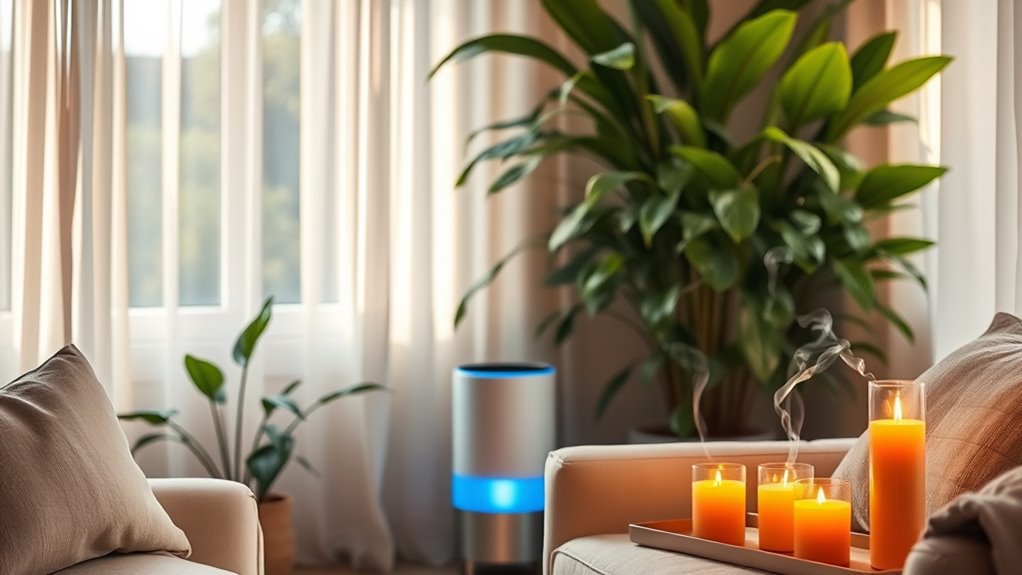
You mightn’t realize how common fragrance sensitivity is, with many people experiencing headaches or asthma attacks from scented products.
Over time, exposure to certain fragrances can lead to more serious health risks, including potential links to cancer.
It’s important to be aware of what’s in your candles and how often you use them to protect your health.
Fragrance Sensitivity Symptoms
How do fragrance sensitivities manifest in everyday life? You might experience various symptoms when exposed to scented candles or air fresheners, particularly if you have fragrance sensitivity.
These reactions can range from mild discomfort to more severe health implications.
Here are some common symptoms:
- Headaches or migraines
- Respiratory issues, such as coughing or wheezing
- Nasal congestion or sinus problems
- Skin irritation or rashes
- Fatigue or dizziness
Individuals with asthma or allergies may find that these symptoms worsen with frequent exposure to scented products.
It’s essential to be aware of your sensitivity and the potential triggers lurking in your environment, as they can greatly impact your well-being.
Long-term Health Risks
While many enjoy the pleasant ambiance created by scented candles, long-term exposure to these fragrances can pose significant health risks.
Research shows that frequent use of scented candles can irritate your respiratory system, potentially triggering asthma attacks or allergic reactions, especially if you’re sensitive.
You might also want to be aware that some candles release volatile organic compounds (VOCs), which can lead to various health issues over time.
In fact, some studies suggest a link between burning certain candles and increased cancer risks due to toxic compounds.
As you consider your health and wellbeing, moderation is key.
Always check candle ingredients, as some might contain hidden synthetic chemicals harmful to your health.
Risks Associated With Burning Scented Candles
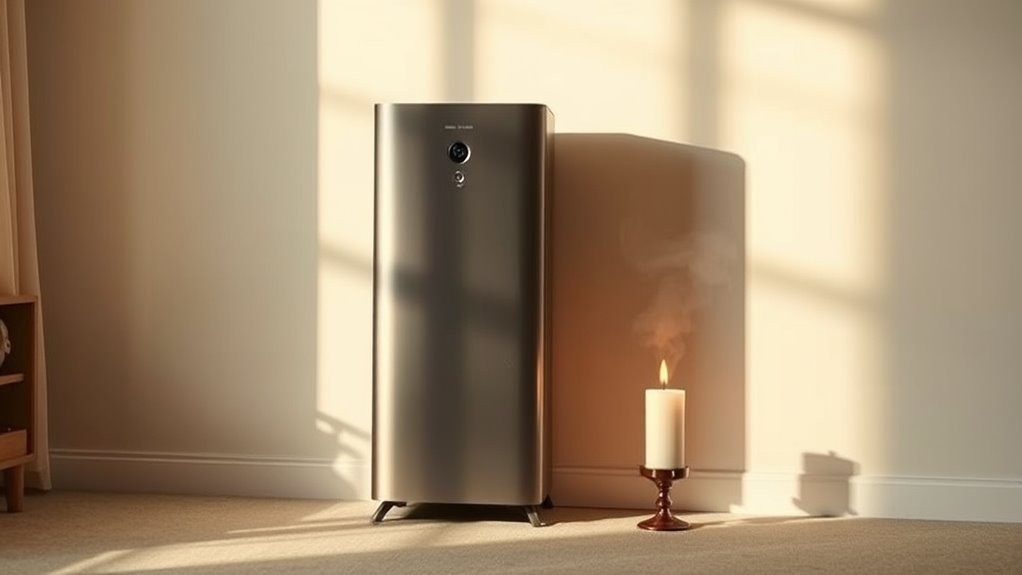
Although many people enjoy the ambiance that scented candles create, burning them can pose significant health risks. The emissions from scented candles contribute to indoor air pollution, which can be particularly concerning for those with asthma or fragrance sensitivities.
Burning scented candles may enhance ambiance but can significantly impact indoor air quality, especially for those with asthma or fragrance sensitivities.
Here are some risks associated with burning scented candles:
- Releases hydrocarbons like toluene and benzene
- Produces fine particulate matter that can exceed WHO limits
- Irritates the respiratory system, potentially triggering asthma attacks
- May contain undisclosed synthetic chemicals linked to health issues
- Incense sticks used alongside can produce four times more particulate matter than cigarettes
Being aware of these risks can help you make informed choices about your indoor air quality and overall health.
Choosing Safer Candle Alternatives
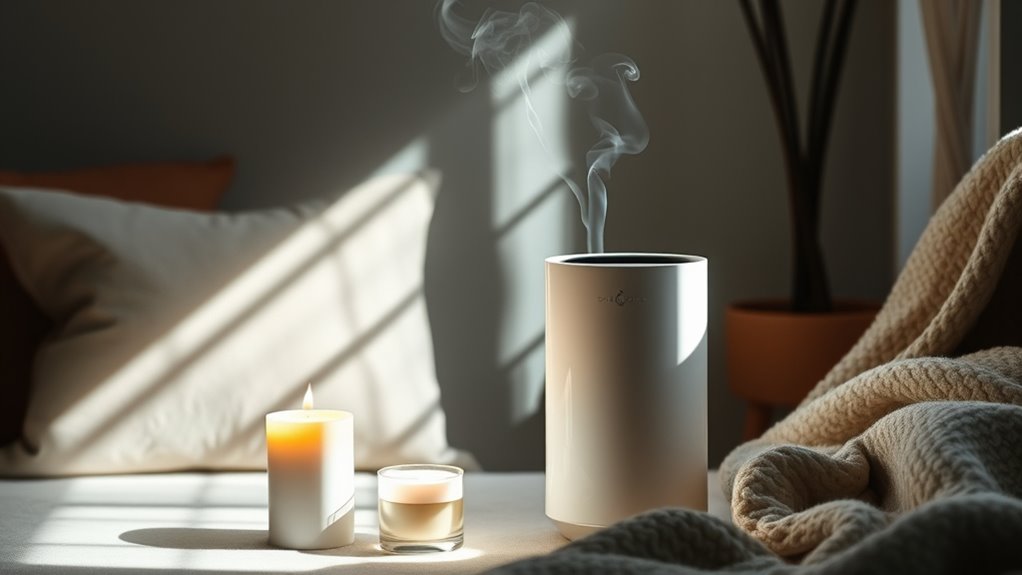
Are you looking for ways to enjoy the warmth and fragrance of candles without compromising your health? Consider these safer alternatives that enhance your indoor environment while minimizing volatile organic compounds (VOCs):
| Candle Type | Benefits |
|---|---|
| Beeswax | Natural, non-toxic, air-cleaning |
| Soy (non-GMO) | Cleaner burning, safer option |
| Palm Oil | Non-toxic, but check sourcing |
| Dye-Free | Fewer harmful chemicals released |
| Cotton/Paper Wicks | Safer than metal-core options |
Enhancing Indoor Air Quality With Air Purifiers
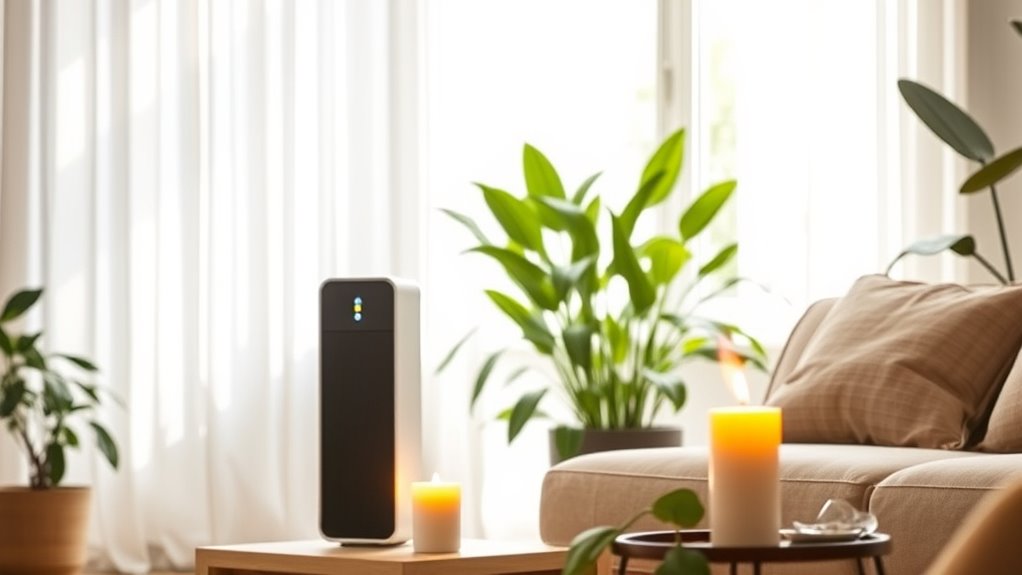
If you want to breathe easier at home, using air purifiers can greatly enhance your indoor air quality.
These devices effectively remove harmful toxins, including volatile organic compounds (VOCs) and particulate matter, often released by scented candles. By incorporating an air purifier, you can enjoy a fresher atmosphere without the adverse effects of candle emissions.
- Real-time air quality monitoring
- Multi-layered filtration systems (HEPA and activated carbon)
- Reduction of allergens and chemical pollutants
- Improved comfort and sleep quality
- A safer alternative to burning candles
Investing in an air purifier not only supports a healthier environment but also complements your home fragrance experience without compromising your well-being.
Tips for a Healthier Candle Experience
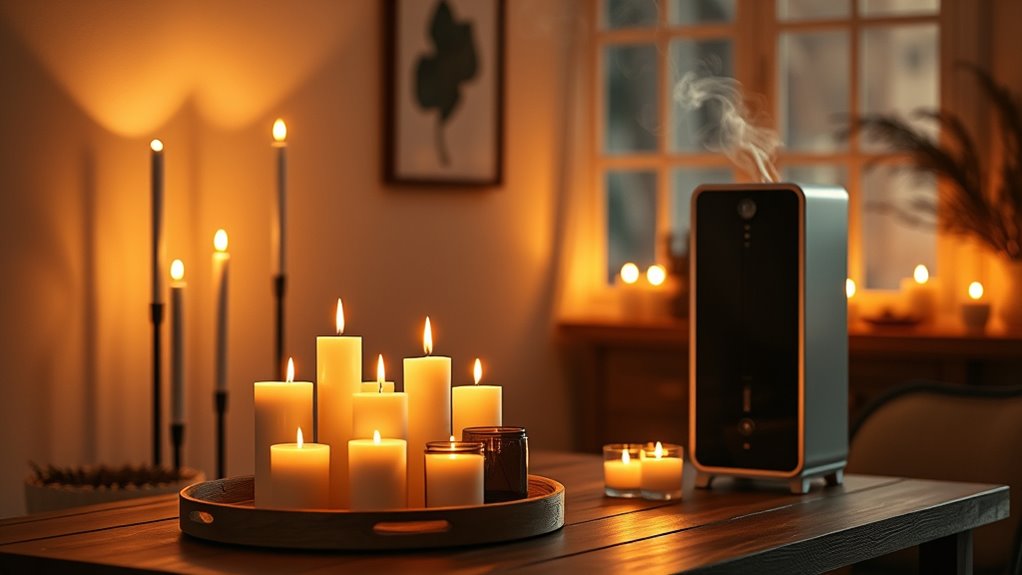
How can you enjoy the cozy ambiance of candles while keeping your indoor air cleaner? Start by trimming candle wicks to about one inch before burning. This simple step reduces smoke and soot emissions, lowering your exposure to volatile organic compounds (VOCs).
Limit your candle burn time to four hours to minimize harmful pollutants. Always light your candles in well-ventilated areas to disperse any toxins released during burning, enhancing your comfort and safety.
Opt for dye-free candles to avoid inhaling harmful chemicals from synthetic dyes. Finally, if you have pets, research essential oil safety, as some scented candles can be harmful to them.
Frequently Asked Questions
Do Scented Candles Affect Air Quality?
Yes, scented candles can affect air quality. When you burn them, they emit harmful substances like toluene and benzene, which contribute to indoor air pollution.
You mightn’t realize it, but these candles can release fine particulate matter that can be inhaled, leading to potential health issues. In fact, the particles can exceed safe limits, worsening the air you breathe.
Can You Burn a Candle in a Room With an Air Purifier?
You can light a candle in a room with an air purifier, but remember, “you can’t have your cake and eat it too.”
The candle’s smoke and scent can release harmful compounds that might overwhelm the purifier.
If you do choose to burn one, keep the space well-ventilated and guarantee your purifier’s filters are clean.
This way, you’ll enjoy the fragrance without compromising your air quality too much.
Do Air Purifiers Help With Fragrance Smell?
Yes, air purifiers can help reduce fragrance smells in your space.
They work by filtering out airborne particles and volatile organic compounds (VOCs) that contribute to odors. While they won’t completely eliminate the scent, they can considerably lower its intensity.
However, it’s still a good idea to practice proper ventilation and limit the use of strongly scented products for the best air quality.
Combining these methods will create a fresher, healthier environment for you.
Is It Okay to Light a Scented Candle in an Air Conditioned Room?
You can’t have your cake and eat it too, especially when it comes to lighting scented candles in an air-conditioned room.
While it might seem cozy, burning candles can release harmful pollutants that may worsen air quality. If you do light one, make sure the space is well-ventilated.
Using an air purifier can help filter out some of those emissions, but moderation is key for maintaining a healthy indoor environment.
Conclusion
In the dance between fragrance and air quality, finding harmony is key. Think of your home as a symphony; too many scented candles can drown out the clarity of fresh air. Research shows that some candles release harmful VOCs, much like a discordant note in your favorite song. By choosing safer alternatives and using air purifiers, you can create a soothing atmosphere without sacrificing your health. Embrace the balance, and let your space sing with both fragrance and freshness.
